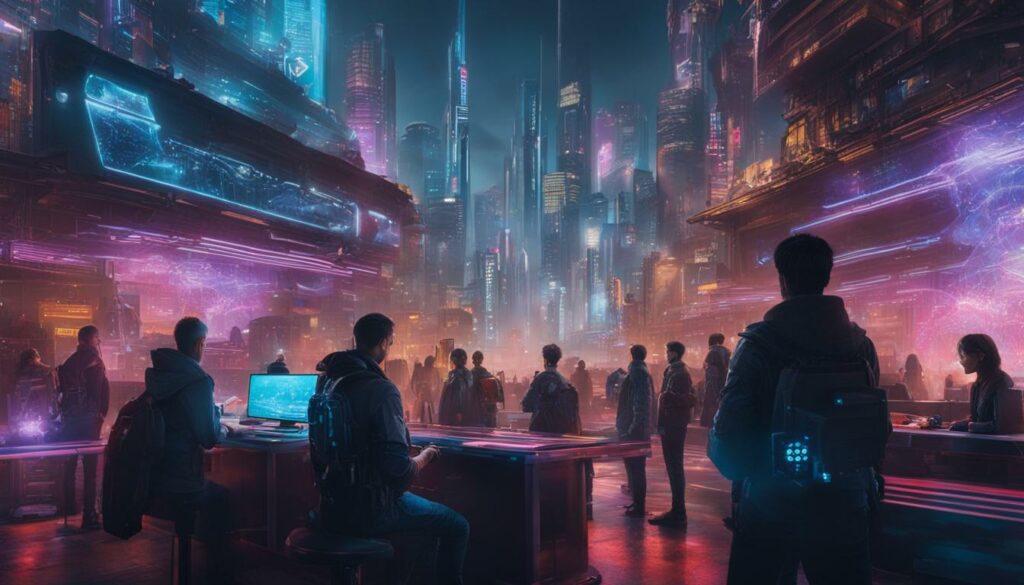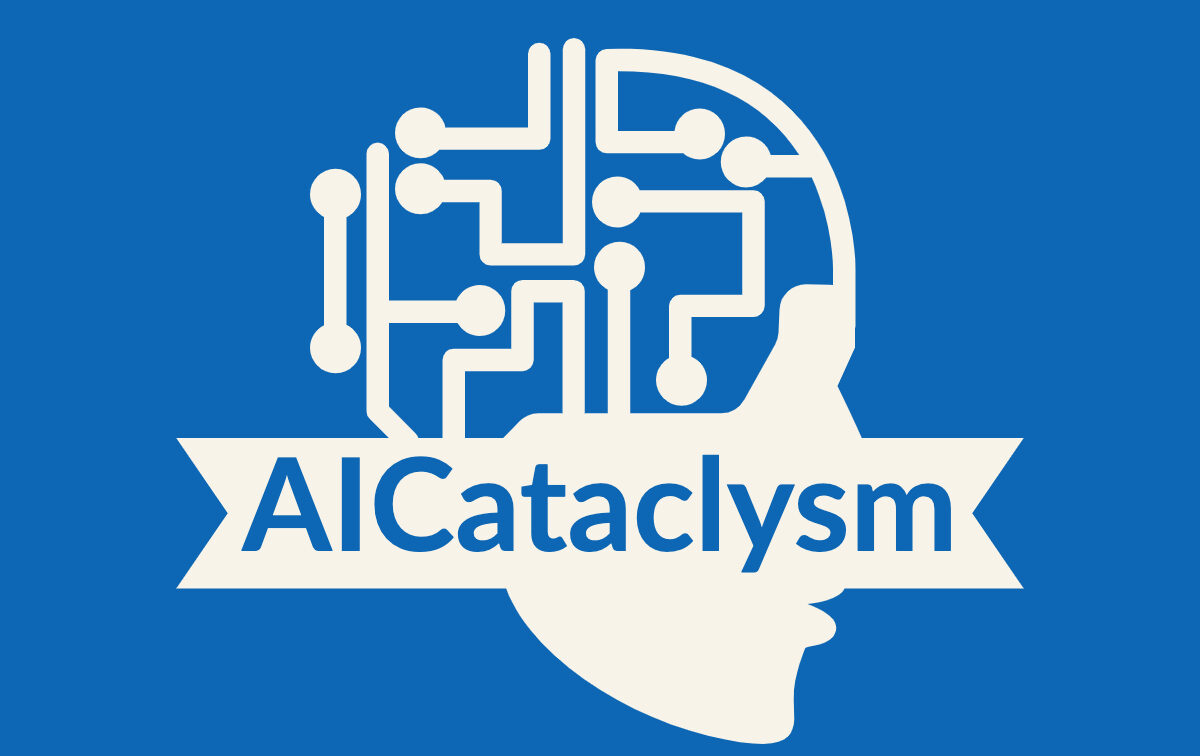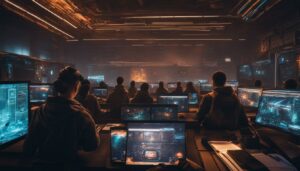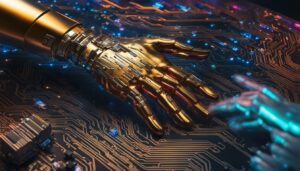The rapid advancements in artificial intelligence (AI) and automation technologies have sparked concerns about the future of work. In this article, I will explore the impact of AI on the job market and argue that rather than replacing humans, AI will augment and redefine our roles, creating new opportunities and empowering us to work more efficiently and creatively.
Key Takeaways:
- AI and automation technologies will not entirely replace humans in the workforce, but rather redefine our roles.
- The evolving landscape of work is shaped by technological advancements, including AI.
- AI is designed to augment human capabilities, automating repetitive tasks and freeing up time for higher-value activities.
- AI has the potential to create new job opportunities across various sectors, requiring skilled professionals.
- The most promising scenario is collaboration between humans and AI, where AI serves as a tool to enhance decision-making and efficiency.
The Evolving Landscape of Work
The evolving landscape of work is being shaped by technological advancements and the increasing integration of AI and automation technologies. As we navigate the changing job market, it is essential to understand how these advancements are transforming the way we work.
Technological advancements in work have disrupted traditional industries and created new opportunities. Automation technologies have the potential to automate certain tasks, leading to concerns about job displacement. However, it is important to recognize that these technologies also have the potential to create new jobs and enhance existing ones. The evolving landscape of work is not about humans being replaced by AI, but about humans and AI working together to achieve greater efficiency and productivity.
In today’s changing job market, adaptability is key. As new technologies emerge, the skills required in the workplace are also evolving. The ability to learn and adapt to technological advancements is becoming increasingly important. Workers must be willing to acquire new skills and embrace the opportunities presented by AI and automation. By doing so, they can stay ahead in a rapidly changing job market and take advantage of the evolving landscape of work.
Overall, the evolving landscape of work is characterized by technological advancements that are reshaping industries and creating new opportunities. It is essential for individuals and organizations alike to embrace these changes and be proactive in adapting to the evolving job market. By leveraging the potential of AI and automation technologies, we can enhance productivity, drive innovation, and navigate the future of work with confidence.
Table: Comparison of Traditional vs. Evolving Job Market
| Traditional Job Market | Evolving Job Market |
|---|---|
| Manual labor | Emphasis on digital skills |
| Limited opportunities for career growth | Increased potential for career development |
| Fixed working hours | Flexible work arrangements |
| Minimal use of technology | Integration of AI and automation |
| Reliance on hierarchical structures | Collaborative and agile work environments |
Augmenting Human Intelligence
Artificial intelligence (AI) is revolutionizing the way we work, but rather than replacing humans, it is designed to augment our capabilities. One of the key benefits of AI is its ability to automate repetitive and mundane tasks, freeing up valuable time for humans to focus on more complex and strategic activities that require creativity, critical thinking, emotional intelligence, and complex problem-solving skills.
By taking over routine tasks such as data entry, administrative work, and data analysis, AI allows us to work more efficiently and make better use of our unique human qualities. This automation of repetitive tasks not only increases productivity but also reduces the risk of human error, leading to higher accuracy and improved outcomes.
“AI frees up time for humans to focus on higher-value activities that require creativity, critical thinking, emotional intelligence, and complex problem-solving skills.”
In addition to automating repetitive tasks, AI has the potential to enhance our capabilities in various domains. For example, in healthcare, AI-powered diagnostic tools can analyze medical images and data to assist doctors in making accurate diagnoses. In the field of finance, AI algorithms can analyze vast amounts of data to identify patterns and trends, helping financial professionals make informed investment decisions.
Overall, AI serves as a powerful tool that complements human intelligence rather than replacing it. By leveraging AI technology, we can unlock new possibilities and achieve greater efficiency, productivity, and innovation in the workplace.
Table: AI Capabilities and Human Tasks
| AI Capabilities | Human Tasks |
|---|---|
| Automation of repetitive tasks | Focus on complex problem-solving |
| Data analysis and pattern recognition | Interpretation of insights and decision making |
| Natural language processing | Communication and empathy |
| Image and speech recognition | Creative thinking and innovation |
As AI continues to advance, it is crucial for individuals to adapt and develop the necessary skills to work alongside AI technologies effectively. This involves acquiring skills in data analysis, programming, critical thinking, and emotional intelligence, which are complementary to AI capabilities. By upskilling and embracing the collaboration between humans and AI, we can thrive in the evolving workplace and maximize the benefits that AI brings.
Job Creation
As artificial intelligence (AI) continues to advance, it has the potential to create numerous job opportunities across various sectors. Contrary to popular belief, AI is not here to replace humans but to work alongside us, augmenting our capabilities and driving innovation. The integration of AI into industries will require skilled professionals who can develop, implement, and maintain AI systems.
There will be a growing demand for individuals with expertise in AI technologies, data analysis, programming, and critical thinking. These skilled professionals will play a crucial role in harnessing the power of AI to enhance productivity and efficiency in the workplace. Additionally, new job roles will emerge to manage AI projects, interpret AI-generated insights, and ensure ethical and responsible AI use.
| Job Opportunities | Skills Required |
|---|---|
| AI Developer | Proficiency in programming languages, machine learning, and algorithms |
| Data Analyst | Ability to analyze and interpret complex data sets, knowledge of statistical methods and data visualization |
| Ethical AI Specialist | Understanding of ethical considerations in AI, knowledge of bias mitigation techniques |
| AI Project Manager | Strong leadership and project management skills, ability to oversee the development and deployment of AI solutions |
These are just a few examples of the job opportunities that will arise as AI becomes more prevalent. The demand for skilled professionals in AI will continue to grow as industries recognize the potential of this technology to revolutionize their operations. It is crucial for individuals to adapt and acquire the necessary skills to thrive in an AI-driven workplace.
The key to harnessing the job creation potential of AI lies in embracing continuous learning, upskilling, and reskilling. By investing in acquiring new skills that are complementary to AI technologies, individuals can position themselves for the job opportunities of the future. Developing expertise in data analysis, programming, critical thinking, and emotional intelligence will be invaluable in a world where AI becomes an integral part of our professional lives.
Collaboration and Human-Machine Partnership
Collaboration between humans and AI is the key to unlocking the full potential of both. Rather than viewing AI as a threat, we should embrace it as a powerful tool that can enhance our capabilities and drive innovation. By working together in a partnership, humans can leverage the unique qualities that AI brings to the table, leading to better decision-making, increased efficiency, and improved outcomes.
Human-machine partnership requires the right balance of skills and expertise. While AI excels at processing vast amounts of data and making predictions based on patterns, humans possess critical thinking, emotional intelligence, and creativity. By combining these strengths, we can tackle complex challenges that neither humans nor AI could address alone.
“The partnership between humans and AI represents a new era of collaboration. Together, we can achieve groundbreaking advancements and create a future where AI serves as a valuable tool, augmenting human intelligence and contributing to the betterment of society.”
AI’s ability to automate repetitive and mundane tasks allows humans to focus on higher-level cognitive activities. This shift in focus enables us to tap into our creativity, develop innovative solutions, and engage in meaningful work that requires empathy and interpersonal skills. As AI takes care of time-consuming tasks, we can allocate our energy towards more impactful endeavors, ultimately increasing productivity and job satisfaction.
Table: Examples of Human-Machine Collaboration
| Collaboration Scenario | Benefits |
|---|---|
| AI-assisted medical diagnosis | Improved accuracy and efficiency in detecting diseases, allowing doctors to make more informed decisions. |
| AI-powered customer service chatbots | 24/7 availability, quick response time, and personalized interactions, enhancing customer satisfaction. |
| AI-driven predictive maintenance | Reduced downtime, optimized maintenance schedules, and increased equipment lifespan, leading to cost savings. |
| AI-guided data analysis | Real-time insights, identification of patterns and trends, and data-driven decision-making, enabling businesses to stay competitive. |
By embracing AI as a tool and fostering a collaborative mindset, we can pave the way for a future where humans and machines work hand in hand, capitalizing on each other’s strengths. This partnership has the potential to revolutionize industries, drive economic growth, and expand our understanding of what is possible. Together, humans and AI can shape a world where the boundaries of innovation are constantly pushed, leading to a brighter and more prosperous future.
Upskilling and Reskilling
The rapid integration of AI in the workplace calls for a proactive approach from individuals to adapt and thrive in an AI-driven workplace. Upskilling and reskilling are essential strategies to stay relevant and navigate the evolving job market. By acquiring new skills and expanding our knowledge, we can align ourselves with the changing demands of the industry and seize new opportunities.
Adapting to an AI-driven workplace requires identifying the skills that are complementary to AI technologies. In-demand skills such as data analysis, programming, critical thinking, and emotional intelligence can significantly enhance our value in the job market. These skills enable us to harness the power of AI and maximize its potential to drive innovation and efficiency.
“The future belongs to those who are willing to constantly learn, unlearn, and relearn.” – Alvin Toffler
Continuous Learning and Professional Development
To successfully adapt to the changing landscape, it is important to cultivate a mindset of continuous learning and embrace lifelong education. This can be achieved through various means, such as online courses, workshops, conferences, and professional development programs. By investing in self-improvement and acquiring new knowledge and skills, we position ourselves as valuable assets in the job market and increase our employability.
Furthermore, organizations and educational institutions play a crucial role in facilitating upskilling and reskilling opportunities. Collaboration between employers, employees, and educational institutions can lead to tailored training programs that address the specific needs and requirements of an AI-driven workplace. By fostering a culture of learning and providing access to resources and support, organizations can ensure their workforce remains adaptable and capable of harnessing the potential of AI.
| Benefits of Upskilling and Reskilling | Strategies for Upskilling and Reskilling |
|---|---|
|
|
As the workplace continues to evolve, upskilling and reskilling will become even more crucial for individuals aiming to thrive in their careers. By embracing the opportunities presented by AI and investing in continuous learning, we can future-proof our skills and unlock new professional horizons in an AI-driven world.
Ethical Considerations and Social Impact
The rapid integration of artificial intelligence (AI) into various industries has raised important ethical considerations. It is crucial to ensure that AI is deployed responsibly and ethically to address potential bias and support the individuals affected by its implementation.
Addressing Bias in AI
One of the key challenges in AI development is addressing bias in algorithms and datasets. AI systems are trained on data that may contain prejudices or reflect societal biases, which can result in discriminatory outcomes. To combat this, developers must actively strive to create diverse and unbiased datasets, as well as implement algorithms that are designed to detect and mitigate bias. Additionally, ongoing monitoring and auditing of AI systems can help identify and rectify any unintended bias in real-world applications.
| Ethical AI Practices | Addressing Bias in AI | Supporting Affected Individuals |
|---|---|---|
| Ensuring transparency in AI decision-making processes. | Implementing diverse and unbiased datasets. | Providing resources for retraining and upskilling. |
| Promoting accountability for AI system developers and users. | Continuously monitoring and auditing AI systems for bias. | Offering financial assistance for affected individuals. |
| Protecting user privacy and data security. | Mitigating bias through algorithmic adjustments. | Establishing support networks and counseling services. |
Supporting Affected Individuals
As AI technologies automate certain tasks, individuals whose roles become obsolete may face challenges in transitioning to new employment opportunities. To mitigate the impact of job displacement, it is crucial to provide support and resources for affected individuals. This support can include access to retraining programs, upskilling initiatives, and financial assistance to help them acquire the skills necessary to thrive in the AI-driven job market. Additionally, establishing support networks and counseling services can aid in the psychological and emotional well-being of those affected by AI-related job changes.
By embracing ethical AI practices, addressing bias, and supporting affected individuals, we can harness the potential of AI while minimizing its negative social impact. It is through responsible deployment and thoughtful consideration of the ethical implications that we can shape an AI-powered future that benefits all members of society.
Key Takeaways
As we navigate the evolving landscape of work, it is clear that AI will not replace human jobs but rather redefine them. By embracing AI as an enabler, we can unlock new possibilities, enhance productivity, and focus on the uniquely human qualities that drive innovation and success.
Key takeaways on AI and jobs:
- AI augments human intelligence by automating repetitive tasks, freeing up time for higher-value activities that require creativity and critical thinking.
- AI creates job opportunities by increasing the demand for skilled professionals to develop, implement, and maintain AI systems.
- Collaboration between humans and AI systems offers the most promising scenario, with AI complementing human capabilities and amplifying our potential for better decision-making and efficiency.
- Upskilling and reskilling are essential for individuals to adapt to the changing workplace driven by AI, acquiring new skills in data analysis, programming, critical thinking, and emotional intelligence.
- Ethical considerations are crucial in responsible AI deployment, addressing bias and ensuring transparency. Society must also prioritize supporting individuals affected by job displacement and provide retraining opportunities.

By leveraging AI technologies and adapting our skill sets, we can maximize the benefits of AI while creating new job opportunities that cater to human strengths. The future of work lies in the collaboration between humans and AI, with humans developing skills that complement and leverage the power of AI.
The future of work is not a dystopian world where humans are replaced by machines, but a world where humans and AI work together harmoniously, leveraging each other’s strengths. As AI continues to evolve, our roles will adapt, and new possibilities will emerge. It is up to us to embrace the potential of AI, upskill ourselves, and shape a future where humans thrive alongside AI.
Conclusion
After exploring the impact of AI on the job market, it is clear that AI will not replace humans but rather work alongside us. The fear of job loss is based on an oversimplified perspective that fails to recognize the collaborative potential between humans and AI. By embracing AI as an enabler, we can unlock new possibilities and enhance productivity in the workplace.
Collaboration is key in the future of work. By leveraging the power of AI technologies, humans can focus on their uniquely human qualities such as creativity, critical thinking, and problem-solving skills. AI can assist us in making better decisions, reducing errors, and improving efficiency. We must view AI as a tool that amplifies our potential, driving innovation and success.
Reskilling and adapting our skill sets are crucial for navigating the changing job market. As AI automates certain tasks, there will be a greater demand for individuals to acquire new skills that complement AI technologies. By developing skills in data analysis, programming, critical thinking, and emotional intelligence, we can remain valuable in the job market.
Ultimately, the future of work lies in the partnership between humans and AI. By cultivating collaboration, embracing continuous learning, and taking a proactive approach, we can shape a future where humans and AI work together harmoniously. Rather than fearing AI, we should recognize its potential to create new job opportunities that cater to human strengths. Through collaboration, reskilling, and adaptability, we can build a future where humans and AI thrive together.
FAQ
Can AI replace some human jobs?
No, AI is designed to augment human capabilities, not replace humans. It automates repetitive and mundane tasks, allowing humans to focus on higher-value activities that require creativity, critical thinking, emotional intelligence, and complex problem-solving skills.
Will AI create new job opportunities?
Yes, as AI technology continues to advance, there will be a growing demand for skilled professionals to develop, implement, and maintain AI systems. Additionally, new roles will emerge to manage AI projects, interpret AI-generated insights, and ensure ethical and responsible AI use.
How can humans collaborate with AI?
AI can complement human capabilities by assisting us in making better decisions, reducing errors, and improving efficiency. With the right training and guidance, AI can become an indispensable tool, amplifying our potential and driving innovation.
What skills should individuals develop to adapt to AI-driven workplaces?
To adapt to the changing landscape, individuals need to invest in continuous learning, upskilling, and reskilling. Developing skills in data analysis, programming, critical thinking, and emotional intelligence will become increasingly valuable in the job market.
How can we ensure ethical AI practices?
Ensuring ethical AI practices, addressing bias, and maintaining transparency are critical aspects of responsible AI deployment. It is essential to prioritize proper training, oversight, and accountability to maintain ethical AI use.
What support should be provided to individuals affected by job displacement due to AI?
As certain job roles become obsolete, society must prioritize providing support and retraining opportunities to affected individuals. This can include programs for upskilling and reskilling, job placement assistance, and financial support during the transition.
What is the key takeaway about AI and jobs?
The key takeaway is that AI will not replace humans’ jobs but rather redefine them. By embracing AI as an enabler, we can unlock new possibilities, enhance productivity, and focus on the uniquely human qualities that drive innovation and success.






